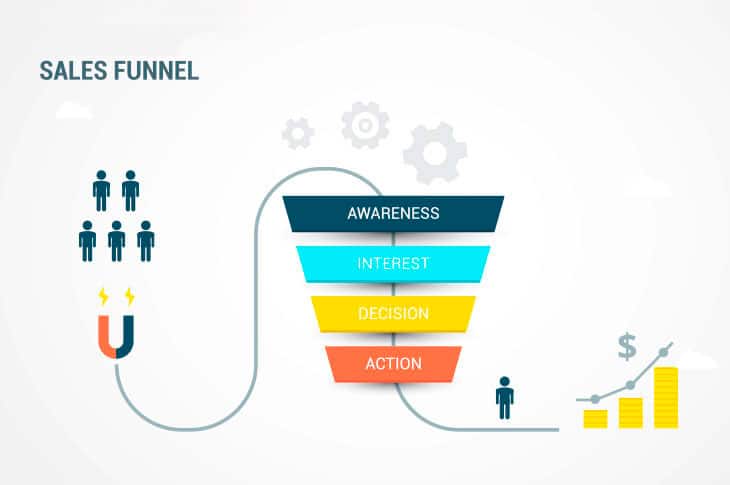Over the last few decades, the internet has become one of the most powerful sources, on a global level, for tourist information.
According to a report on tourist trends (2018-2019) by IPK International, in a matter of just 10 years, the use of the internet for tourist purposes has doubled, rising from 46% to 82 %. Direct hotel reservations (38%), airlines (27%), along with other tourism providers, have all increased their online sales.
So, on paper, it appears that the circumstances are ideal for travel companies who are operating online. Nevertheless, there is fierce competition in this sector. Such competition coupled with a lack of web optimization could mean you are missing out on your slice of this scrumptious ‘online’ sales cake.
So, the question is how do you make sure you are getting a big slice of this cake? Well, here’s some of Affilired’s recommendations to help you optimize your conversion funnel to make sure you don’t miss any potential online sales. Although there are two types of funnels (Sales and Marketing), for today’s post we will only be focusing on the sales funnel.
What is the conversion funnel?
Although it varies according to the type of business, in general terms the funnel has the same objective for every business: to increase the conversion rate.

This image illustrates the general funnel for all types of businesses. It shows the path of the potential consumer to the point of final conversion, which is known as the Customer Journey.The conversion funnel, however, although it shows all these stages, doesn’t just focus on one single user, but rather on the number of users that enter your website and the points at which they leave it, thus narrowing the path, hence the name funnel. By pinpointing where the vast majority of consumers leave your website, you can then optimize these points and therefore prevent potential customers from not completing their bookings.
How to optimize the different steps of the funnel.
Importantly, the special needs of the tourism sector need to be taken into account during each optimization step.
First step: Attention
This is the first step in the process when the user begins to dream about travelling and starts their online search for inspiration until hopefully, they land on your website.
How to optimize the Attention step?
At this point, you need to be very clear about your “buyer’s persona”. It is simply not enough to expect them to click your website directly or arrive there by referral or by organic search. You have to dedicate your efforts towards gaining more traffic by:
- The creation of alluring online marketing campaigns:
-
- AdWords: with a moderate budget you can have great results.
- Social networks: with millions of users, these are platforms with great potential, if the appropriate segmentation is carried out.
- Affiliation marketing: links pointing to your site throughout hundreds of affiliates who are promoting your products will help you to increase your traffic, therefore, increasing the probability of conversion.
-
- Create quality content on your blog, paying attention to the keywords you want to use to achieve organic positioning.
- Take advantage of the lure of social networks by posting offers or content that will attract your potential buyer’s attention.
Second step: Interest
Once you have them on your website, you need to arouse their curiosity, keep them interested so they continue navigating and learn what you have to offer them.
How to optimize the Interest step?
This is the step where, if your dropout rate is quite considerably high, it could be because your website is perhaps too difficult to understand and/or to navigate, or maybe your products are simply not generating enough interest.
At this point, you have to ask yourself is your website design is simple enough? Are the images attractive? Can the user easily find what they are looking for? In short, does your website have good usability?
To generate more interaction, put special offers on the home page that will interest potential buyer’s and hopefully keep them browsing. Another good idea is to make sure that the subscription to your newsletter is visible and simple.
Third step: Desire
This is the moment you need to build up their trust and increase their desire to purchase on your webpage.
How to optimize the Desire step?
At this point, the user is hopefully very close to making their final decision and just needs some persuasive arguments to help reinforce their intention to purchase. Something that works very well, at this stage is, to show some positive reviews from other satisfied users of your product or service. It is all about enhancing those reassuring messages and other positive elements that build confidence in your product, thus influencing the final decision to purchase.
Fourth step: Action
The last and final stage, the white glove test, the big question is will you pass it? This is the moment when the user has decided to go ahead with their purchase, for example, make a reservation at your hotel.
How to optimize the Action step?
Here you really must simplify this step, make sure the ordering and payment process run smoothly. Offer a discount for being their 1st sale or place “an upgrade at a special price”, could be the key to that final step, moving from user to customer, and who knows if in a short term, becoming a brand advocate as well.
